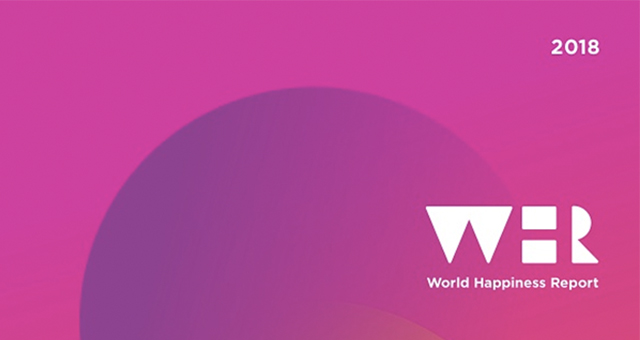By: CIFAR
29 Aug, 2018

March 20, 2018 marked the fifth annual International Day of Happiness and the launch of the World Happiness Report 2018 at the United Nations in New York City.
CIFAR partnered with the UN Sustainable Development Solutions Network (SDSN) to host a panel discussion on the findings of the World Happiness Report 2018, which includes a special focus on international migration.
The World Happiness Report is a globally recognized survey of the happiness levels of people across the world.Increasingly, governments and civil rights groups use report data and insights to inform policy and practice. Launching the 2018 Report in New York, CIFAR and the SDSN convened report editors, report writers, and invited guests from government and civil society organizations to share and discuss key themes from the report such as voluntary and involuntary migration, migrant and host experiences, socioeconomic integration, and global urbanization.
The session was prefaced by the Chef de Cabinet to the President of the General Assembly, Ambassador František Ružička. Panellists, including report editors John Helliwell (CIFAR Distinguished Fellow, University of British Columbia), Richard Layard (London School of Economics), and Jeffrey Sachs (Columbia University), along with chapter contributors Martijn Hendriks (Erasmus University Rotterdam) and Julie Ray (Gallup), shared key insights from the report. These are summarized below.
Roundtable on Migration: Key Takeaways
Migration boosts happiness on average.
Migrants report a 9% increase in happiness following their migration and most happiness gains come after the first five years of living in a new country. As their standards and expectations adjust to those of their native-born counterparts, increases in happiness diminish. The characteristics of a destination country have measurable effects on the happiness of immigrants.
Happiness means a lot more than just income.
Happiness is usually measured by a person’s living conditions (workplace, education, health, etc.), something that isn’t accounted for in GDP. Report findings indicate migrants aren’t happiest in the richest countries but rather in the countries with the highest happiness rankings.
Happiness is increasingly used as a measure of human well-being.
Potential contributors to human happiness include GDP per capita, freedom to make life choices, generosity and prosocial behaviour, a lower level of political corruption, personal income, and support networks. Finland ranks as the happiest country in the world in this regard.
Happiness levels converge in OECD countries.
The happiness levels of immigrants who are arriving in countries with higher happiness rankings than their own experience a boost to their own personal happiness. Happiness surveys of millions in both Canada and the U.K. have illuminated the impact of one’s environment on their happiness.
The gain in happiness for migrants occurs at different levels.
Happiness increases for migrants who move from one country to another within the same region of the world. Happiness also increases for immigrants who move from one region of the world to another.
The gain in happiness for Latin American immigrants is lower than that for immigrants from other regions.
Latin American countries on average have higher happiness rankings than other regions that are contributors to immigration. Subsequently, their gains are smaller when they move to countries with higher happiness rankings than their own. The above-average happiness rankings for Latin American countries may be explained by the strong familial and social ties found in these countries.
Happiness levels of a person’s home country leave an imprint on their personal happiness levels.
Immigrants have slightly lower happiness levels than their native-born counterparts if they come from a country with a lower happiness ranking than their new home. Immigrants coming from happier countries often have slightly higher happiness levels than native-born citizens.
For migrants moving to countries with a higher happiness ranking than their home country, the effects of immigration also boost the happiness of family members left back home.
Gains in happiness of family members left behind are higher for migrants that move from developing to developed regions due to remittances. The relationship, however, does not work both ways as some immigrants sacrifice their own personal happiness to improve the lives of their family members back home. Finally, family members back home also experience rises in unhappiness as well as happiness possibly due to anxieties about their family abroad, although the rise in happiness is generally greater.
Immigrants are happier in countries that are more accepting to newcomers.
Integration of immigrants into destination countries is typically more successful in relatively tolerant countries. The volume of immigration, the mindset of native residents, the willingness of immigrants to engage with locals and the effect of immigration flows on low-skill job opportunities for locals affect the level of acceptance immigrants receive in their destination countries. Locals of more tolerant countries also have higher happiness levels than those in less tolerant countries.
The implications of the report suggest migration can be a tool of increasing world happiness.
However, a better understanding of the causal pathways of immigration is needed for migration to be used reliably as a tool for happiness. Further study is needed to shed light on the state of an individual’s happiness before they migrate and to understand the conditions of the destination countries. Further happiness research will provide more insights into these areas.
CIFAR is a registered charitable organization supported by the governments of Canada and Quebec, as well as foundations, individuals, corporations and Canadian and international partner organizations.